Yang Sun
LFD: Layer Fused Decoding to Exploit External Knowledge in Retrieval-Augmented Generation
Aug 27, 2025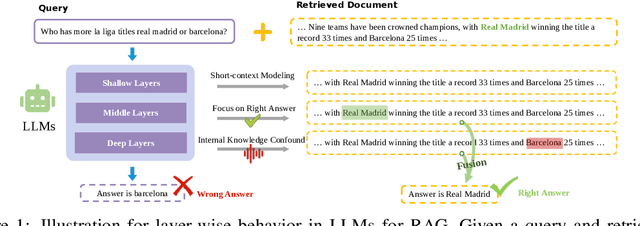
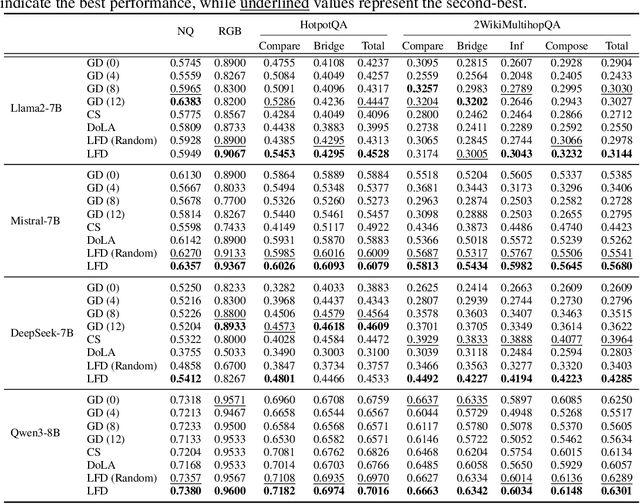
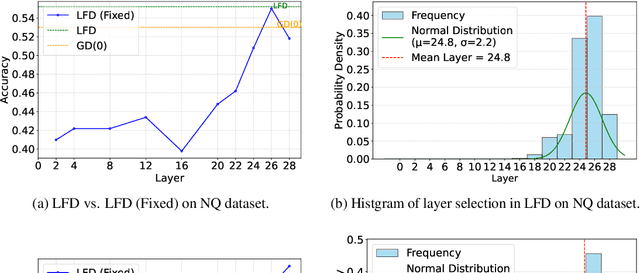
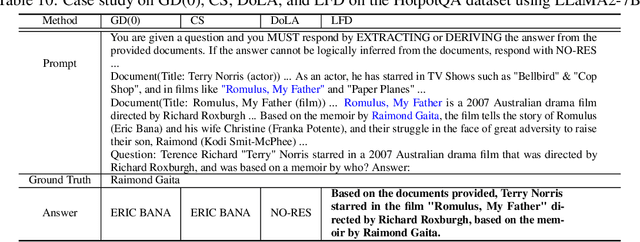
Abstract:Retrieval-augmented generation (RAG) incorporates external knowledge into large language models (LLMs), improving their adaptability to downstream tasks and enabling information updates. Surprisingly, recent empirical evidence demonstrates that injecting noise into retrieved relevant documents paradoxically facilitates exploitation of external knowledge and improves generation quality. Although counterintuitive and challenging to apply in practice, this phenomenon enables granular control and rigorous analysis of how LLMs integrate external knowledge. Therefore, in this paper, we intervene on noise injection and establish a layer-specific functional demarcation within the LLM: shallow layers specialize in local context modeling, intermediate layers focus on integrating long-range external factual knowledge, and deeper layers primarily rely on parametric internal knowledge. Building on this insight, we propose Layer Fused Decoding (LFD), a simple decoding strategy that directly combines representations from an intermediate layer with final-layer decoding outputs to fully exploit the external factual knowledge. To identify the optimal intermediate layer, we introduce an internal knowledge score (IKS) criterion that selects the layer with the lowest IKS value in the latter half of layers. Experimental results across multiple benchmarks demonstrate that LFD helps RAG systems more effectively surface retrieved context knowledge with minimal cost.
CodeContests+: High-Quality Test Case Generation for Competitive Programming
Jun 06, 2025Abstract:Competitive programming, due to its high reasoning difficulty and precise correctness feedback, has become a key task for both training and evaluating the reasoning capabilities of large language models (LLMs). However, while a large amount of public problem data, such as problem statements and solutions, is available, the test cases of these problems are often difficult to obtain. Therefore, test case generation is a necessary task for building large-scale datasets, and the quality of the test cases directly determines the accuracy of the evaluation. In this paper, we introduce an LLM-based agent system that creates high-quality test cases for competitive programming problems. We apply this system to the CodeContests dataset and propose a new version with improved test cases, named CodeContests+. We evaluated the quality of test cases in CodeContestsPlus. First, we used 1.72 million submissions with pass/fail labels to examine the accuracy of these test cases in evaluation. The results indicated that CodeContests+ achieves significantly higher accuracy than CodeContests, particularly with a notably higher True Positive Rate (TPR). Subsequently, our experiments in LLM Reinforcement Learning (RL) further confirmed that improvements in test case quality yield considerable advantages for RL.
Graph-Reward-SQL: Execution-Free Reinforcement Learning for Text-to-SQL via Graph Matching and Stepwise Reward
May 18, 2025Abstract:Reinforcement learning (RL) has been widely adopted to enhance the performance of large language models (LLMs) on Text-to-SQL tasks. However, existing methods often rely on execution-based or LLM-based Bradley-Terry reward models. The former suffers from high execution latency caused by repeated database calls, whereas the latter imposes substantial GPU memory overhead, both of which significantly hinder the efficiency and scalability of RL pipelines. To this end, we propose a novel Text-to-SQL RL fine-tuning framework named Graph-Reward-SQL, which employs the GMNScore outcome reward model. We leverage SQL graph representations to provide accurate reward signals while significantly reducing inference time and GPU memory usage. Building on this foundation, we further introduce StepRTM, a stepwise reward model that provides intermediate supervision over Common Table Expression (CTE) subqueries. This encourages both functional correctness and structural clarity of SQL. Extensive comparative and ablation experiments on standard benchmarks, including Spider and BIRD, demonstrate that our method consistently outperforms existing reward models.
DPGP: A Hybrid 2D-3D Dual Path Potential Ghost Probe Zone Prediction Framework for Safe Autonomous Driving
Apr 23, 2025



Abstract:Modern robots must coexist with humans in dense urban environments. A key challenge is the ghost probe problem, where pedestrians or objects unexpectedly rush into traffic paths. This issue affects both autonomous vehicles and human drivers. Existing works propose vehicle-to-everything (V2X) strategies and non-line-of-sight (NLOS) imaging for ghost probe zone detection. However, most require high computational power or specialized hardware, limiting real-world feasibility. Additionally, many methods do not explicitly address this issue. To tackle this, we propose DPGP, a hybrid 2D-3D fusion framework for ghost probe zone prediction using only a monocular camera during training and inference. With unsupervised depth prediction, we observe ghost probe zones align with depth discontinuities, but different depth representations offer varying robustness. To exploit this, we fuse multiple feature embeddings to improve prediction. To validate our approach, we created a 12K-image dataset annotated with ghost probe zones, carefully sourced and cross-checked for accuracy. Experimental results show our framework outperforms existing methods while remaining cost-effective. To our knowledge, this is the first work extending ghost probe zone prediction beyond vehicles, addressing diverse non-vehicle objects. We will open-source our code and dataset for community benefit.
Open set label noise learning with robust sample selection and margin-guided module
Jan 08, 2025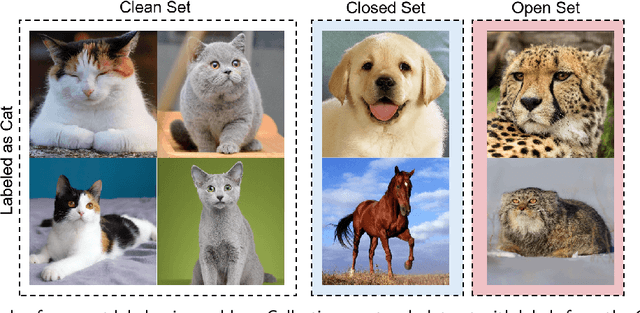



Abstract:In recent years, the remarkable success of deep neural networks (DNNs) in computer vision is largely due to large-scale, high-quality labeled datasets. Training directly on real-world datasets with label noise may result in overfitting. The traditional method is limited to deal with closed set label noise, where noisy training data has true class labels within the known label space. However, there are some real-world datasets containing open set label noise, which means that some samples belong to an unknown class outside the known label space. To address the open set label noise problem, we introduce a method based on Robust Sample Selection and Margin-Guided Module (RSS-MGM). Firstly, unlike the prior clean sample selection approach, which only select a limited number of clean samples, a robust sample selection module combines small loss selection or high-confidence sample selection to obtain more clean samples. Secondly, to efficiently distinguish open set label noise and closed set ones, margin functions are designed to filter open-set data and closed set data. Thirdly, different processing methods are selected for different types of samples in order to fully utilize the data's prior information and optimize the whole model. Furthermore, extensive experimental results with noisy labeled data from benchmark datasets and real-world datasets, such as CIFAR-100N-C, CIFAR80N-O, WebFG-469, and Food101N, indicate that our approach outperforms many state-of-the-art label noise learning methods. Especially, it can more accurately divide open set label noise samples and closed set ones.
Learning Implicit Features with Flow Infused Attention for Realistic Virtual Try-On
Dec 16, 2024Abstract:Image-based virtual try-on is challenging since the generated image should fit the garment to model images in various poses and keep the characteristics and details of the garment simultaneously. A popular research stream warps the garment image firstly to reduce the burden of the generation stage, which relies highly on the performance of the warping module. Other methods without explicit warping often lack sufficient guidance to fit the garment to the model images. In this paper, we propose FIA-VTON, which leverages the implicit warp feature by adopting a Flow Infused Attention module on virtual try-on. The dense warp flow map is projected as indirect guidance attention to enhance the feature map warping in the generation process implicitly, which is less sensitive to the warping estimation accuracy than an explicit warp of the garment image. To further enhance implicit warp guidance, we incorporate high-level spatial attention to complement the dense warp. Experimental results on the VTON-HD and DressCode dataset significantly outperform state-of-the-art methods, demonstrating that FIA-VTON is effective and robust for virtual try-on.
Complex-Cycle-Consistent Diffusion Model for Monaural Speech Enhancement
Dec 12, 2024



Abstract:In this paper, we present a novel diffusion model-based monaural speech enhancement method. Our approach incorporates the separate estimation of speech spectra's magnitude and phase in two diffusion networks. Throughout the diffusion process, noise clips from real-world noise interferences are added gradually to the clean speech spectra and a noise-aware reverse process is proposed to learn how to generate both clean speech spectra and noise spectra. Furthermore, to fully leverage the intrinsic relationship between magnitude and phase, we introduce a complex-cycle-consistent (CCC) mechanism that uses the estimated magnitude to map the phase, and vice versa. We implement this algorithm within a phase-aware speech enhancement diffusion model (SEDM). We conduct extensive experiments on public datasets to demonstrate the effectiveness of our method, highlighting the significant benefits of exploiting the intrinsic relationship between phase and magnitude information to enhance speech. The comparison to conventional diffusion models demonstrates the superiority of SEDM.
Are Existing Road Design Guidelines Suitable for Autonomous Vehicles?
Sep 13, 2024



Abstract:The emergence of Autonomous Vehicles (AVs) has spurred research into testing the resilience of their perception systems, i.e. to ensure they are not susceptible to making critical misjudgements. It is important that they are tested not only with respect to other vehicles on the road, but also those objects placed on the roadside. Trash bins, billboards, and greenery are all examples of such objects, typically placed according to guidelines that were developed for the human visual system, and which may not align perfectly with the needs of AVs. Existing tests, however, usually focus on adversarial objects with conspicuous shapes/patches, that are ultimately unrealistic given their unnatural appearances and the need for white box knowledge. In this work, we introduce a black box attack on the perception systems of AVs, in which the objective is to create realistic adversarial scenarios (i.e. satisfying road design guidelines) by manipulating the positions of common roadside objects, and without resorting to `unnatural' adversarial patches. In particular, we propose TrashFuzz , a fuzzing algorithm to find scenarios in which the placement of these objects leads to substantial misperceptions by the AV -- such as mistaking a traffic light's colour -- with overall the goal of causing it to violate traffic laws. To ensure the realism of these scenarios, they must satisfy several rules encoding regulatory guidelines about the placement of objects on public streets. We implemented and evaluated these attacks for the Apollo, finding that TrashFuzz induced it into violating 15 out of 24 different traffic laws.
DTN: Deep Multiple Task-specific Feature Interactions Network for Multi-Task Recommendation
Aug 21, 2024



Abstract:Neural-based multi-task learning (MTL) has been successfully applied to many recommendation applications. However, these MTL models (e.g., MMoE, PLE) did not consider feature interaction during the optimization, which is crucial for capturing complex high-order features and has been widely used in ranking models for real-world recommender systems. Moreover, through feature importance analysis across various tasks in MTL, we have observed an interesting divergence phenomenon that the same feature can have significantly different importance across different tasks in MTL. To address these issues, we propose Deep Multiple Task-specific Feature Interactions Network (DTN) with a novel model structure design. DTN introduces multiple diversified task-specific feature interaction methods and task-sensitive network in MTL networks, enabling the model to learn task-specific diversified feature interaction representations, which improves the efficiency of joint representation learning in a general setup. We applied DTN to our company's real-world E-commerce recommendation dataset, which consisted of over 6.3 billion samples, the results demonstrated that DTN significantly outperformed state-of-the-art MTL models. Moreover, during online evaluation of DTN in a large-scale E-commerce recommender system, we observed a 3.28% in clicks, a 3.10% increase in orders and a 2.70% increase in GMV (Gross Merchandise Value) compared to the state-of-the-art MTL models. Finally, extensive offline experiments conducted on public benchmark datasets demonstrate that DTN can be applied to various scenarios beyond recommendations, enhancing the performance of ranking models.
Overview of AI-Debater 2023: The Challenges of Argument Generation Tasks
Jul 24, 2024



Abstract:In this paper we present the results of the AI-Debater 2023 Challenge held by the Chinese Conference on Affect Computing (CCAC 2023), and introduce the related datasets. We organize two tracks to handle the argumentative generation tasks in different scenarios, namely, Counter-Argument Generation (Track 1) and Claim-based Argument Generation (Track 2). Each track is equipped with its distinct dataset and baseline model respectively. In total, 32 competing teams register for the challenge, from which we received 11 successful submissions. In this paper, we will present the results of the challenge and a summary of the systems, highlighting commonalities and innovations among participating systems. Datasets and baseline models of the AI-Debater 2023 Challenge have been already released and can be accessed through the official website of the challenge.
 Add to Chrome
Add to Chrome Add to Firefox
Add to Firefox Add to Edge
Add to Edge